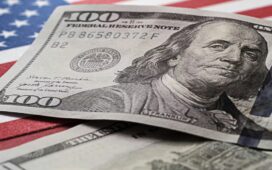Gold price (XAU/USD) holds positive ground around $4,370 after reaching a fresh record high near $4,380 during the early Asian session on Tuesday. Traders continue to assess the developments surrounding the US government shutdown, prospects for further rate cuts by the Federal Reserve (Fed) and renewed US credit risks.
The ongoing US federal government shutdown could boost the safe-haven flows, supporting the Gold price. The government shutdown has entered its 21th days with no end in sight, after senators failed for the 10th time to resolve the impasse in votes on Thursday. The shutdown is now the third-longest funding lapse in modern history.
Additionally, expectations of a Fed rate cut contribute to the yellow metal’s upside. Traders are currently pricing in nearly a 99% possibility that the US central bank will cut interest rates again next week, followed by another reduction in December, according to the CME FedWatch tool. Lower interest rates could reduce the opportunity cost of holding Gold, supporting the non-yielding precious metal.
On the other hand, any signs of easing trade tensions between the US and China, the world’s two largest economies, could dampen demand for safe-haven assets such as gold. Comments from US President Donald Trump alleviated some concerns around its tensions with China, saying that they will have a “fair deal,” with the two sides slated to meet in the coming days.
All eyes will be on the US September Consumer Price Index (CPI) inflation data later on Friday due to the government shutdown-driven data drought. If the reports show a hotter-than-expected outcome, this could lift the US Dollar (USD) and undermine the USD-denominated commodity price in the near term.
Gold FAQs
Gold has played a key role in human’s history as it has been widely used as a store of value and medium of exchange. Currently, apart from its shine and usage for jewelry, the precious metal is widely seen as a safe-haven asset, meaning that it is considered a good investment during turbulent times. Gold is also widely seen as a hedge against inflation and against depreciating currencies as it doesn’t rely on any specific issuer or government.
Central banks are the biggest Gold holders. In their aim to support their currencies in turbulent times, central banks tend to diversify their reserves and buy Gold to improve the perceived strength of the economy and the currency. High Gold reserves can be a source of trust for a country’s solvency. Central banks added 1,136 tonnes of Gold worth around $70 billion to their reserves in 2022, according to data from the World Gold Council. This is the highest yearly purchase since records began. Central banks from emerging economies such as China, India and Turkey are quickly increasing their Gold reserves.
Gold has an inverse correlation with the US Dollar and US Treasuries, which are both major reserve and safe-haven assets. When the Dollar depreciates, Gold tends to rise, enabling investors and central banks to diversify their assets in turbulent times. Gold is also inversely correlated with risk assets. A rally in the stock market tends to weaken Gold price, while sell-offs in riskier markets tend to favor the precious metal.
The price can move due to a wide range of factors. Geopolitical instability or fears of a deep recession can quickly make Gold price escalate due to its safe-haven status. As a yield-less asset, Gold tends to rise with lower interest rates, while higher cost of money usually weighs down on the yellow metal. Still, most moves depend on how the US Dollar (USD) behaves as the asset is priced in dollars (XAU/USD). A strong Dollar tends to keep the price of Gold controlled, whereas a weaker Dollar is likely to push Gold prices up.





